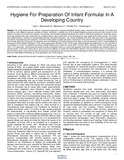Please use this identifier to cite or link to this item:
https://cris.library.msu.ac.zw//handle/11408/1159Full metadata record
| DC Field | Value | Language |
|---|---|---|
| dc.contributor.author | Usai, Tecklah | - |
| dc.contributor.author | Mutonhodza, B. | - |
| dc.contributor.author | Makamure, Charlotte | - |
| dc.contributor.author | Tshalibe, Rumbidzai S. | - |
| dc.contributor.author | Chinofunga, Dorothy | - |
| dc.date.accessioned | 2016-05-01T14:37:18Z | - |
| dc.date.available | 2016-05-01T14:37:18Z | - |
| dc.date.issued | 2013 | - |
| dc.identifier.issn | 2277-8616 | - |
| dc.identifier.uri | http://hdl.handle.net/11408/1159 | - |
| dc.description.abstract | The study determined the efficacy of protocols employed in replacement/artificial feeding using commercial infant formula. The study was carried out in the different suburban locations of Harare, Zimbabwe. A sample size of 20 mothers/caregivers giving commercial infant formula to their babies at between 0-6 months was targeted. Convenience and snowball sampling techniques were used to identify the participants. Interviews using a structured questionnaire were conducted and complemented by direct observation of the participants as they prepared the infant formula. The results were tallied against a checklist of recommended practices and label instructions. The results established that there were short falls in the preparation procedures as employed by the caregivers, mainly the mixing order of powder and water, temperature of the water for reconstitution and handling of left over formula after feed; 50 percent of caregivers were not adhering to the label instructions as given by the manufacturers and to recommendations proposed by World Health Organisation. Poor hand washing was indicative in 80% of the cases. Bottle feeding was predominant (n=16) compared to cup feeding (n=4) and the population practicing artificial feeding were mostly the young (90%), married (80%), educated (100%) and working group (90%). The researcher recommends that health providers strengthen efforts to ensure that adequate information/counselling and consistent advice of optimal benefit to the infant-mother pair be given and that the Ministry of Health and Child Welfare Nutrition unit must strictly monitor the activities and the information given out by infant formula manufacturers as stipulated by the International Code of Marketing of Breast milk Substitutes and also giving them the responsibility of following up on the appropriate use of their products. | en_US |
| dc.language.iso | en | en_US |
| dc.publisher | International Journal of Scientific and Technology Research | en_US |
| dc.relation.ispartofseries | International Journal of Scientific and Technology Research;Vol.2, No. 9 | - |
| dc.subject | Commercial infant formula, caregivers, contamination, hygiene, infants, milk, risk. | en_US |
| dc.title | Hygiene for preparation of infant formular in a developing country | en_US |
| dc.type | Article | en_US |
| item.languageiso639-1 | en | - |
| item.openairetype | Article | - |
| item.cerifentitytype | Publications | - |
| item.openairecristype | http://purl.org/coar/resource_type/c_18cf | - |
| item.fulltext | With Fulltext | - |
| item.grantfulltext | open | - |
| Appears in Collections: | Research Papers | |
Files in This Item:
| File | Description | Size | Format | |
|---|---|---|---|---|
| Hygiene-For-Preparation-Of-Infant-Formular-In-A-Developing-Country.pdf | 214.24 kB | Adobe PDF |  View/Open |
Page view(s)
148
checked on Dec 17, 2025
Download(s)
40
checked on Dec 17, 2025
Google ScholarTM
Check
Items in MSUIR are protected by copyright, with all rights reserved, unless otherwise indicated.



